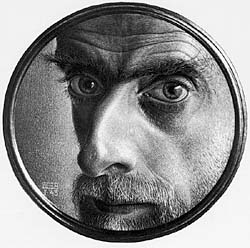
|
Escherís first images in this realm took the form of elaborate patterns in which repeated figures of stylized animals, birds, or fish densely interlock, leaving no spaces between the figures. From about 1940 his work became more fantastic in its spatial effects. In images of bizarre buildings, Escher ingeniously toyed with the viewerís perceptions, creating such optical illusions as staircases that appear to lead both upward and downward in the same direction. He also explored the perceptual conflict created by a surface that appears to be both flat and three-dimensional. In the lithograph Reptiles (1943), for example, parts of a stylized pattern of interlocking alligators seem to come to life, walking off the edge of the paper. Although Escher had no training in mathematics or sciences, his precise and analytical approach to the visual world has had an especially strong appeal to mathematicians and to psychologists interested in visual perception.
Escher was born in Leeuwarden, the Netherlands. From 1919 to 1922 he studied at the School of Architecture and Ornamental Design in Haarlem, where he became highly skilled in the technique of woodcut (seePrints and Printmaking). From 1922 to 1934 he lived in Italy, then successively in Switzerland and Belgium; in 1941 he settled in Baarn, the Netherlands.
|

